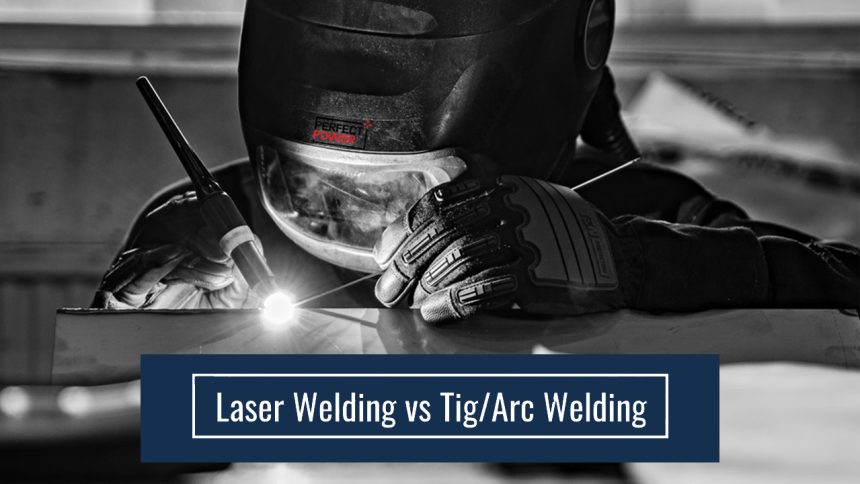Even though it may be difficult to imagine, there was once a period when all welding was done by hand. When the metal was molten, technicians would use a portable torch to reconnect the separated parts. While some applications still employ this technique, it has been mostly supplanted by more contemporary welding techniques.
Laser and arc (TIG) welders are two popular welder types. To help you decide which kind of welder is best for you, we’ll compare and contrast the two methods and discuss their advantages and disadvantages.
Compare laser welding and TIG/Arc welding. Laser welding offers precision and accuracy, while TIG welding is versatile and cost-effective. Choose based on your specific needs.
021208.com
WHAT IS ARC WELDING OR TIG WELDING?
A non-consumable tungsten electrode is used in arc welding, sometimes called TIG welding, to create the weld. The workpiece metal is heated with the electrode until it melts, and the molten metal is then deposited into the joint using the electrode.
Arc welding has a lot of versatility and may be used on various materials, including cast iron, stainless steel, and aluminum. Arc welders commonly produce welds that are exceptionally robust and of excellent quality. Welding is a much safer technique because it produces no smoke or fumes.
Arc welding has the drawback of potentially being more challenging to master than other welding methods. It also needs specialized equipment, which can be costly to buy or rent. Additionally, if you’re not careful, there is a chance of burns due to the technique’s tremendous heat output.
WHAT IS LASER WELDING?
In laser welding, lasers are used to fuse materials. The metal is melted and fused when a laser beam is directed at the seam where two pieces of material meet.
As a result of its capacity to generate joints with extremely high levels of accuracy and repeatability, laser welding is frequently employed in precision welding applications. Additionally, you can use it to join materials that are challenging to weld, like stainless steel or aluminum. Laser welding is also viable for applications demanding tight tolerances because it reduces thermal distortion in the welded pieces.
Laser welding has a few drawbacks as well. First, it requires expensive, sometimes difficult-to-use equipment. Furthermore, laser welding generates a lot of heat, which might be harmful if you’re not careful.
DIFFERENCES AND SIMILARITIES BETWEEN LASER WELDING AND TIG
The following are some of the main parallels and contrasts between laser welding and TIG welding:
| FEATURES | LASER WELDING | ARC/ TIG WELDING |
| Fusing Method | Uses intense laser beams to melt seams together. | Uses filler metal and heat from an electric arc to melt and glue the seams together |
| Oxygen Protect | The laser’s separate nozzle distributes carbon dioxide to the welding area. | An inert gas shield, usually argon, but occasionally helium. |
| Filler Substance | It is not necessary for laser welding. | Popular thin filler metals. |
| Bridging The Gap | A narrow fusion zone and a lack of filler metal cause poor gap bridging. | Wide fusion zone and using filler metal enable effective gap bridging. |
| Remaining Stress And Distortion | Low heat input per unit length produces low residual stress and distortion. | Excessive residual stress and deformation are caused by high heat input per unit length. |
| Typical Uses | Industrial applications. | Private or widespread applications. |
| Key Benefits | The ability to weld various thin and thick metals, along with accuracy and precision, makes it simple to handle challenging connections and produce strong, clean welds. | With less expensive equipment and more control over the welding process, materials with gaps or poor fit can be joined. |
| Principal Drawbacks | Costly initial investment and ongoing maintenance, unsuitable for reactive materials where cracks may form, and challenging to combine surfaces with gaps. | Requires a high level of skill and talent; heat transmission can cause distortion and weaker welds, making the joint more vulnerable to impurities. |
| Efficiency | High productivity and welding rates. | Low productivity and welding speeds. |
| Cracking Tendency | The development of brittle phases. | Solidification cracking is likely. |
| Cooling Speed | Rapid cooling; almost instantaneous material handling after the laser welding. | A slower rate of cooling |
| Effectiveness Overall | Produces spotless, superior welds on a variety of materials. | Produces clean, high-quality welds on a variety of materials. |
COMPARED TO ARC (TIG) WELDING, IS LASER WELDING BETTER?
TIG/ARC WELDING
COMPARED TO ARC (TIG) WELDING, IS LASER WELDING BETTER?
Due to its advantages over more conventional welding techniques like TIG welding, laser welding is a preferred option for many production applications. Compared to TIG welds, laser welds frequently have shorter heat-affected zones and are more precise, which reduces distortion and warp in the finished product.
Laser welding is typically quicker than TIG welding, which might aid in accelerating your manufacturing process.
Laser welding also has the benefit of being extremely accurate. This is possible because the laser beam can precisely focus on the required spot. As a result, there is less chance that the surrounding area will sustain damage, and those sensitive components can be welded without worrying about being harmed.
Additionally, You can employ a range of other materials for laser welding. Metals, polymers, and even glass fall into this category.
On the other hand, TIG welding is typically limited to metals.
Additionally, it moves along quickly. This translates into shorter production times and cheaper total costs. As there is no requirement for filler materials or gas, it is also significantly cleaner than previous processes.
Conclusion
The materials you’re dealing with, their thickness, the intended weld strength, and the aesthetics you’re striving for will all impact the type of welding you select. Consultation with an experienced welder or metal fabricator is the most effective way to determine which welding suits your needs. They can evaluate your unique scenario and provide advice based on their experience.












